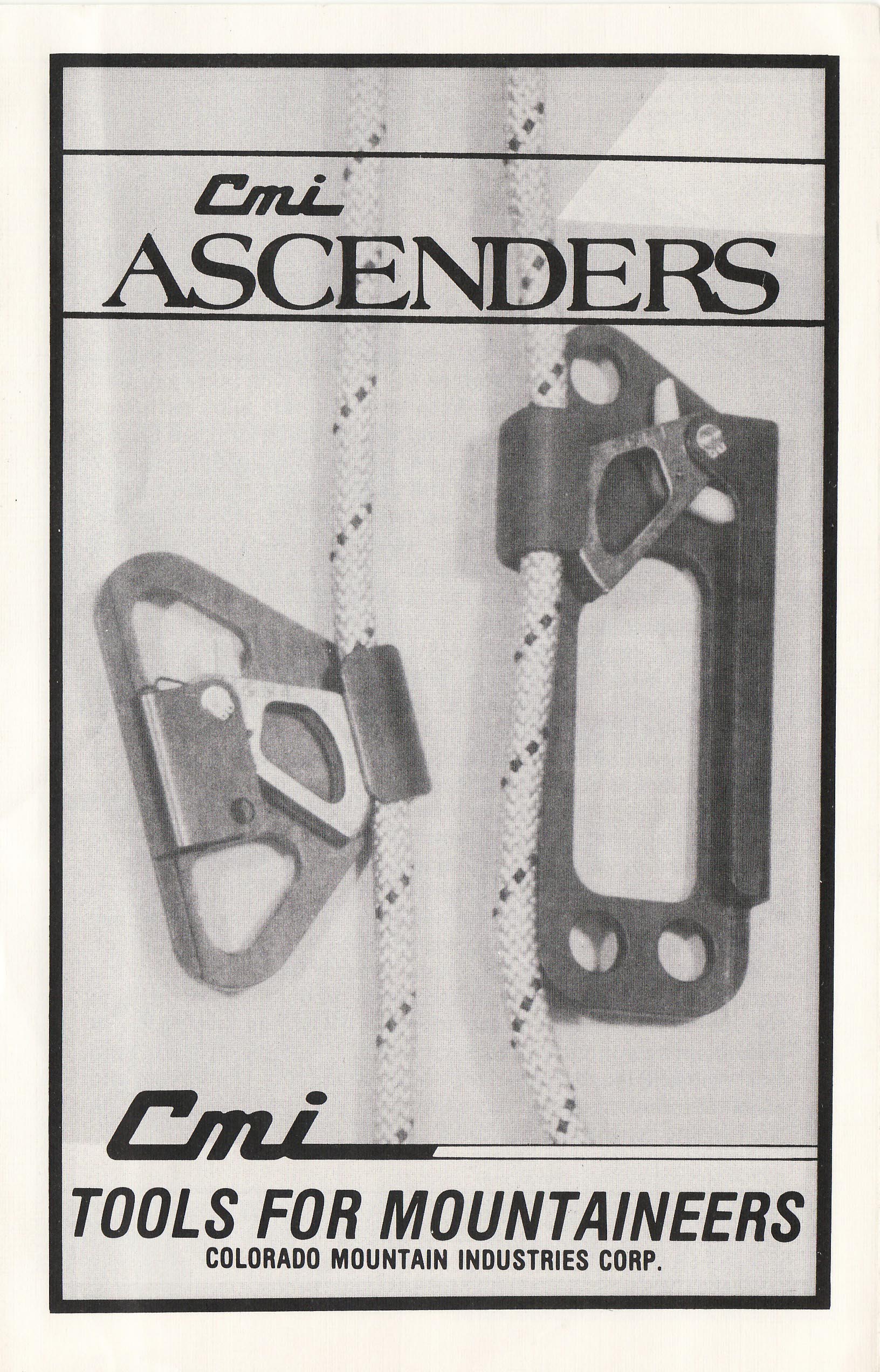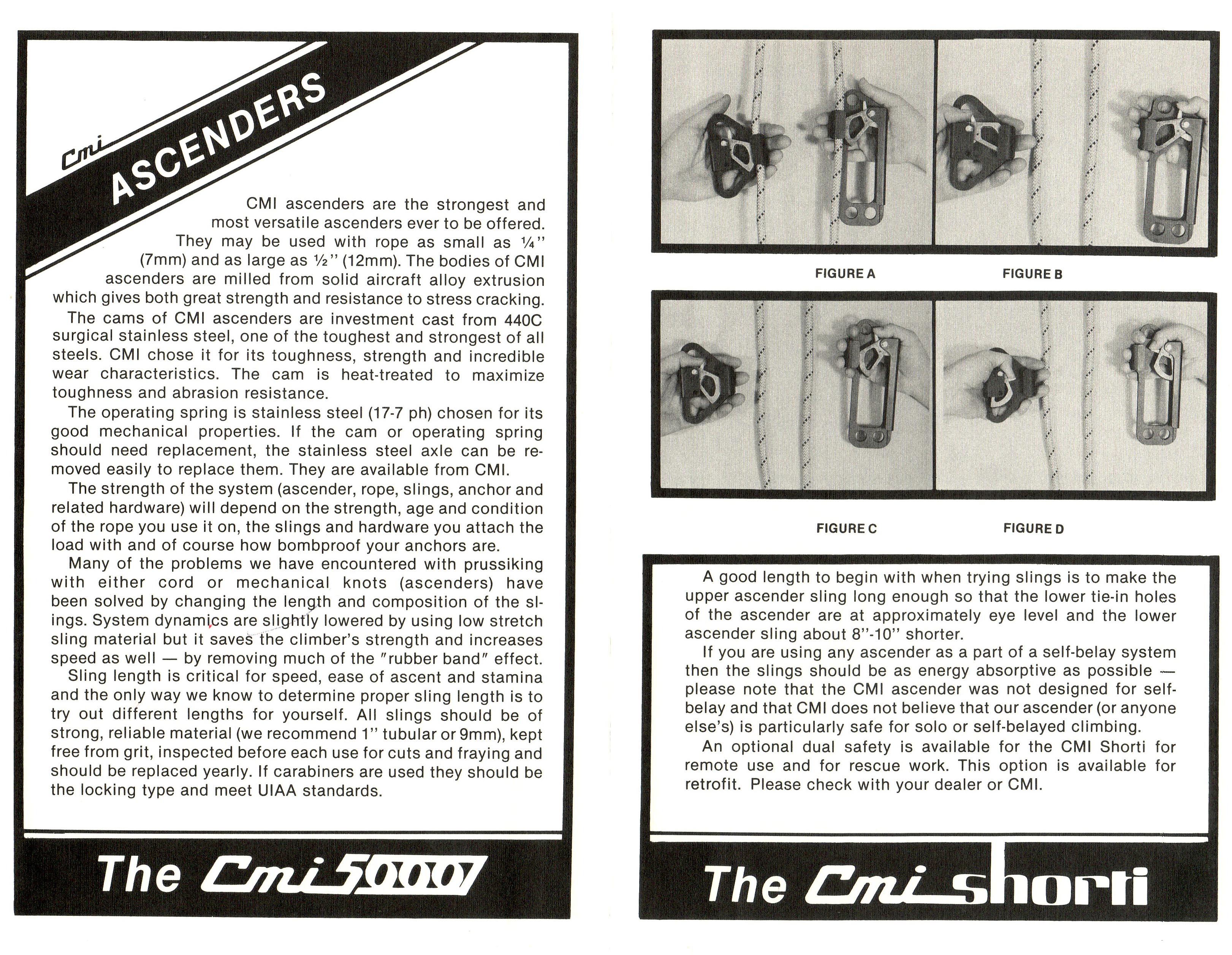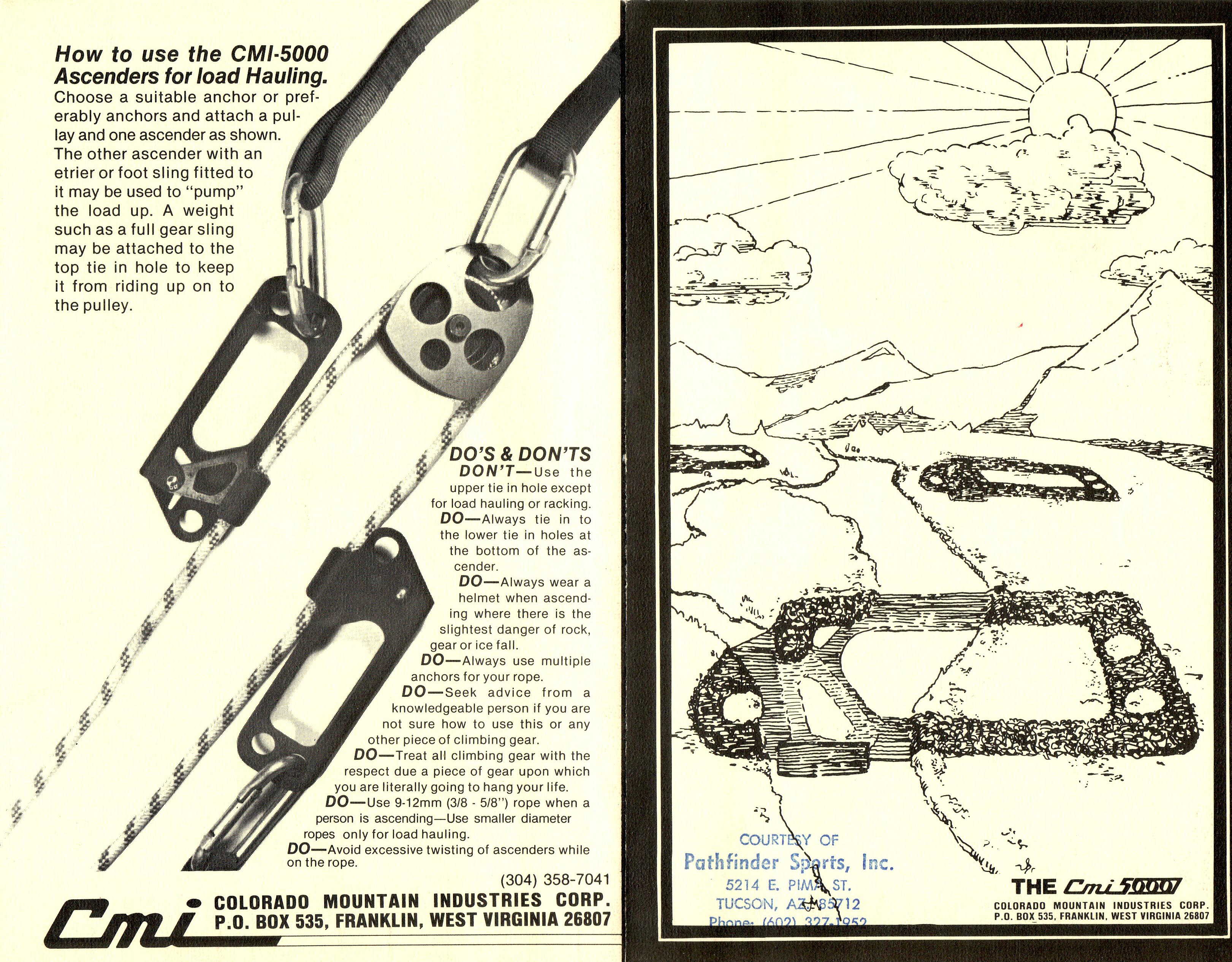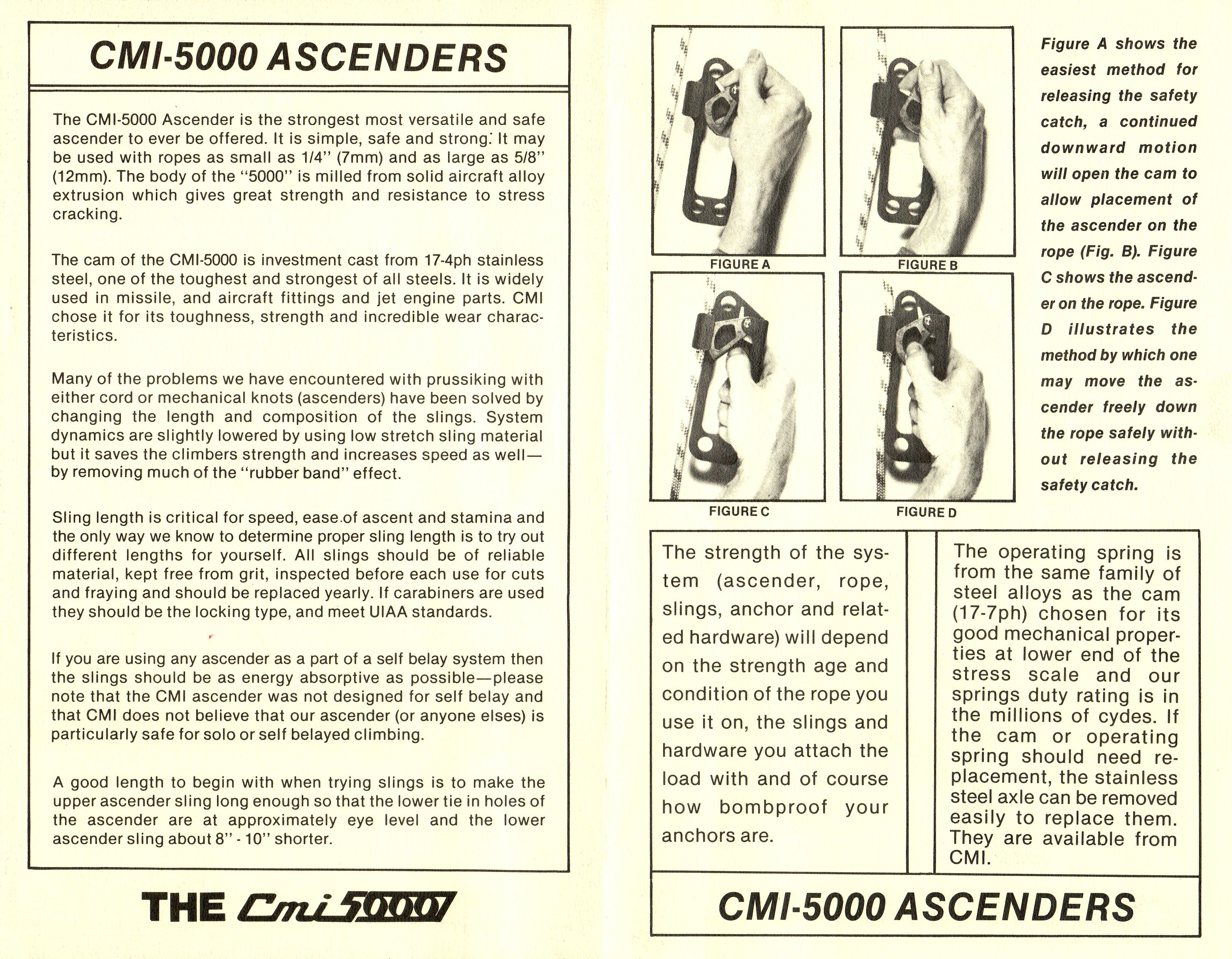Overview
History
There were four sequential models numbered from 5000 through 5004, skipping model number 5001 because of course they did.
Ian Ellis of Speleoshoppe kindly went through his old purchase records to find the approximate time frame for each of the C.M.I. 5000 series ascenders. Apparently the 5000 was introduced in mid-1979, the "5001" in early 1980, the 5002 in late 1980, the 5003 in mid-1984, and the 5004 in mid-1986. Model number 5001 was announced but not used.
The CMI 5000 series were contemporaneous with their junior siblings, the CMI Shorti series. CMI retired both series when they introduced the Large and Small UltrAscenders in 1989
The fastest way to determine which model you have is to read the sticker on the handle, but these are often faded, damaged, or missing. Older stickers were sometimes applied to newer versions. I use the frame finish and shape. Models 5000 and 5002 have anodized frames with 5000s having rectangular rope channels and 5002s having triangular ones. Models 5003 and 5004 have painted frames with 5004s having an internal lip in the rope channel that 5003s lack. The following table provides additional differences between the four models:
| Model |
Extrusion |
Frame
Finish |
Rope
Channel |
Cam
Channel |
Cam |
Safety |
Image(s) |
| 5000 |
5000 |
Anodized |
Rectangular |
No Lip |
No reinforcing bar |
White,
extends above cam |
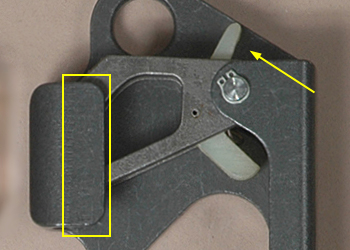 |
| 5002 |
Pentagonal |
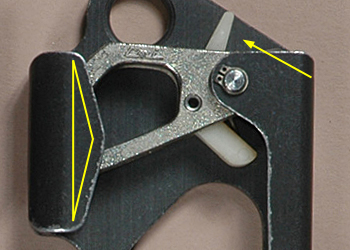 |
| 5003 |
5003 |
Painted |
Reinforcing bar |
Black
Sits flat to cam top |
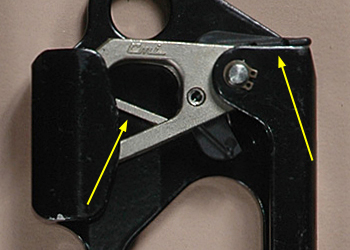
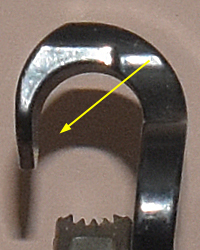 |
| 5004 |
5004 |
Has lip |
Gray
Sits flat to cam top |
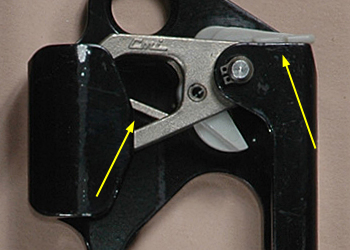
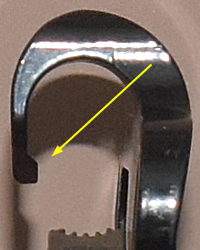 |
Although the 5001 was never officially used, I sometimes separate it from the 5000. The "5001" was scheduled to have a stronger cam spring, a cam change to accommodate the new spring, a repositioned safety, and radiused versus chamfered tie-in holes. Despite the press release, a change to the safety did not appear until the 5003, and I would not call it repositioned until the UltrAscender appeared around 1989. The other changes were made incrementally, so the transition was gradual. For convenience, I use the new cam with "Cmi" instead of "CMI" as the indicator for the 5001.
CMI made smaller changes over the years without changing the model number. I have seventeen versions of the four models in my collection. The following table summarizes differences between the 5000-series ascenders in my collection:
| ID |
Model |
Ver. |
Frame
Holes |
"Cmi" on cam? |
Cam
Finish |
Cam
Teeth |
Cam
Pin |
Safety
Axle Pin |
Notes |
| 2221 |
5000 |
A |
Square edge |
None |
Plain |
5000 pattern
(2)(5.4)^4(3.4)^2(3.2)^2 |
Round-head |
Small |
|
| 2225 |
B |
Chamfered |
Prototype frame, not heat treated. |
| 2222 |
C |
|
| 2299 |
D |
Square edge |
"C M I" |
|
| 27 |
E |
Speleoshoppe custom red anodizing. |
| 3418 |
F |
Chamfered |
2220 |
5000
(a.k.a. "5001") |
G |
Radiused |
"Cmi" |
Mushroom-head in milled recess. |
I use the new cam with "Cmi" instead of "C M I" as my indicator for the 5001. |
| 292 |
H |
Large |
| 3654 |
5002 |
A |
5002 pattern
(3)(5.4)^4(3.4)(3.2)^3 |
|
| 2385 |
B |
Mushroom-head |
|
| 28 |
C |
Chrome-plated |
|
| 3661 |
5003 |
A |
Plated |
5003 pattern
(1)(2.3)^2(4.3)(2.3)^5(2) |
|
| 3677 |
B |
Chrome-plated |
|
| 29 |
C |
Plated |
5004 pattern
(5.4)^2(3.4)^3(3.2) |
|
| 3597 |
5003½ |
D |
5003 parts on a 5004 frame. |
| 30 |
5004 |
A |
|
| 3664 |
B |
Plain |
|
Let’s look at the differences among the four versions in more detail:
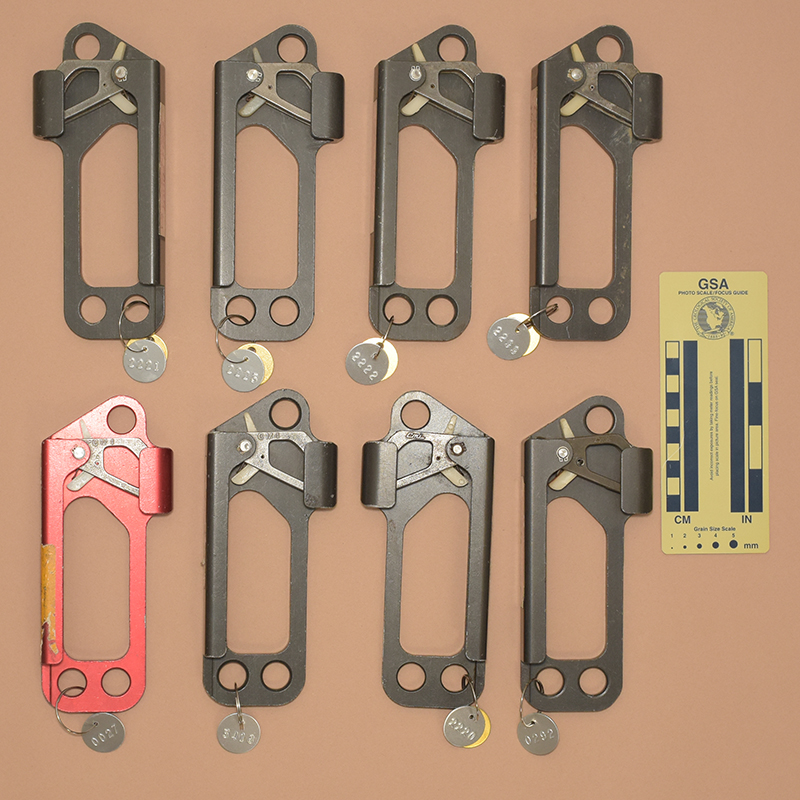 >5000 (1979-1980)
>5000 (1979-1980)
The easiest way to recognize a 5000 is to see an anodized frame with a rectangular rope channel as viewed from the front.
The 5000 safety is a nylon elbow that extends above the frame. This design is shared by the contemporaneous CMi Shorti, the 5002, and its contemporaneous Shorti II.
I have eight versions of the 5000. The frame holes vary having square, chamfered or radiused holes. There are three cam designs, two cam spring roll rivet sizes, and two types of cam axles. One pair is red, a special order made exclusively for Speleoshoppe.
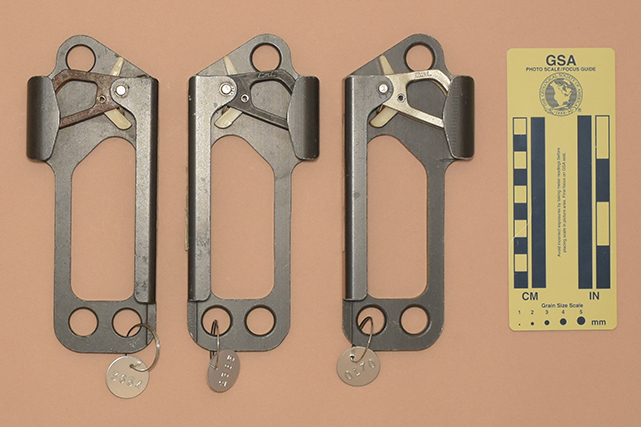 5002 (1980-1984)
5002 (1980-1984)
The easiest way to recognize a 5002 is to see an anodized frame with a pentagonal (“pointed”) rope channel as viewed from the front.
The extrusion used is the same as the 5000 extrusion but it is milled to a different shape. The rope channel is taller than the one on the 5000. This is more than a cosmetic improvement. One strange feature of the 5000 was that the rope-cam contact point was well below the center elevation of the rope channel. The 5002 design places the contact point much closer to channel mid-elevation. This is a cleaner design than the original and indicates at some additional attention to detail.
I have three versions of the 5002. The cams have one more tooth in the top row, to the right (facing the cam) of the previous two. Two of mine have bare cams, one is chrome plated. The cam springs are stronger. Two have longer cam axle pins, allowing elimination of the previous frame recess beneath the pin head.
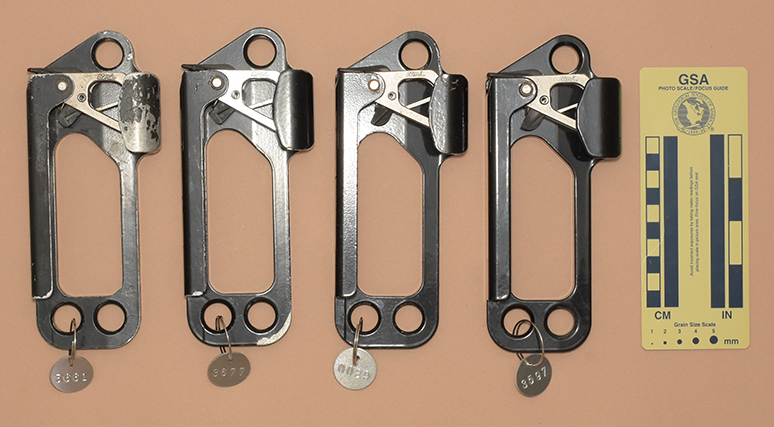 >5003 (1980-1984)
>5003 (1980-1984)
The easiest way to recognize a 5003 is to see painted frame without a lip inside the rope channel.
The 5003 used a new frame extrusion so the back of the frame is no longer flat, but arches behind the rope channel.
The 5003 model seems to be the hardest 5000-series model to find. I have four versions of the 5003 – or maybe three and a half versions – and no duplicates. Two of these have 5003 cams that match Shorti III cams. One cam is plane, the other chrome plated. The other two have 5004 cams, matching Shorti IV cams. One of these 5003 pairs has 5004 frames as well, but it has 5003 safeties and 5003 stickers. Perhaps I should call it a 5004, but perhaps 5003½ is more accurate.
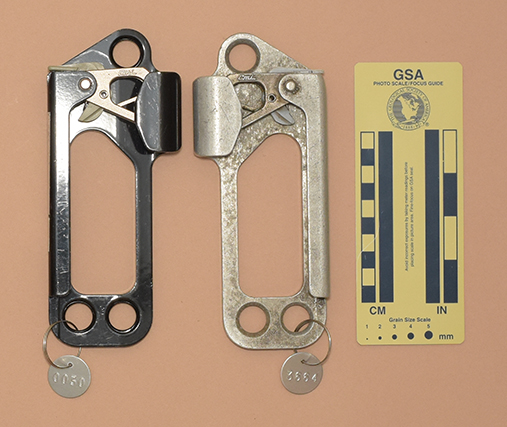 >5004 (1984-1986)
>5004 (1984-1986)
The easiest way to recognize a 5004 is to see painted frame with a lip inside the rope channel.
In 1986 C.M.I. issued a press release noting that "under some unusual circumstances [the C.M.I.] 5003 and Shorty III ascenders can be forced off the rope." It is possible to get some thinner, soft lay ropes to pull out between the cam and the side of the rope channel if one works at it a while, but I have been completely unsuccessful in pulling 11 mm. P.M.I. out of my 5003s under any reasonable circumstances. I have witnessed and photographed soft-lay ropes getting jammed in CMI UltrAscenders, and these use the 5004 extrusions. My advice is that you need to make your ascenders and ropes are compatible, regardless of what brand you choose to use.
I have two versions of the 5004. One is fairly easy for a patient person to find, but the other is strange. Apparently, it was never painted. The cam spring on this ascender was broken when I received it. Since the cam axle is held by a retaining ring rather than being riveted, I was easily able to replace the spring with a new one from my spare parts inventory.
[ Top
| 5000 Ver. B
| 5000 Ver. C
| 5000 Ver. D
| 5000 Ver. E
| 5000 Ver. F
| 5000 Ver. G
| 5000 Ver. H (5001)
]
[ 5002 Ver. A
| 5002 Ver. B
| 5002 Ver. C
| 5003 Ver. A
| 5003 Ver. B
| 5003 Ver. C
| 5003 Ver. D
| 5004 Ver. A
| 5004 Ver. B
| Return to H.E.C. Ascenders
]
5000, Version A
(#2221)
Technical Details
I acquired my CMI 5000, Version A in 2017 as part of Bob Thrun’s collection.
Version A is 184 mm. tall, 76 mm. wide, 27 mm. thick, and weighs 229 g.
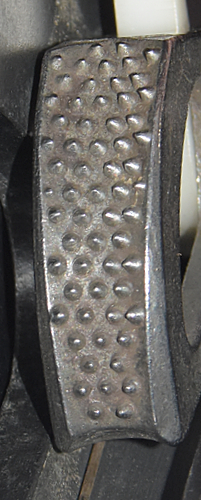 C.M.I. ascender frames are made by milling an aircraft alloy extrusion. The extrusion direction is oriented parallel to the vertical axis of the ascender. The frame contains two opposing channels. One channel is rounded and becomes the rope channel, the other is square and holds the cam. The rope channel is 15 mm. wide. Starting with a length of extrusion, everything that doesn't look like ascender frame is machined away. In particular, the rope channel is shortened, the handle hole is cut, two 15.6 mm. sling attachment holes are drilled at the bottom and a third is drilled at the top, the unused lower portion of the cam channel is cut back, and all the sharp corners are rounded.
C.M.I. ascender frames are made by milling an aircraft alloy extrusion. The extrusion direction is oriented parallel to the vertical axis of the ascender. The frame contains two opposing channels. One channel is rounded and becomes the rope channel, the other is square and holds the cam. The rope channel is 15 mm. wide. Starting with a length of extrusion, everything that doesn't look like ascender frame is machined away. In particular, the rope channel is shortened, the handle hole is cut, two 15.6 mm. sling attachment holes are drilled at the bottom and a third is drilled at the top, the unused lower portion of the cam channel is cut back, and all the sharp corners are rounded.
The cam is a skeletonized casting with a (2)(5.4)^4(3.4)^2(3.2)^2 conical tooth count. The cam radius increases from 32 to 51 mm. over an angle of 49°, giving a 29° cam angle. According to an undated C.M.I. brochure, the cam material is 17-4ph stainless steel. The inner cam face radius reduces from top to bottom of the cam in order to match different diameter ropes. The cam pivot is a solid 6.4 mm. round head pin held by an external retaining ring. The cam safety is an elbow shaped nylon(?) lever mounted on a roll pin in the cam. A single spring serves as cam spring and safety spring. Normally this spring holds the safety where it protrudes from both the top and bottom of the cam. The bottom protrusion interferes with the shell’s cam channel and prevents opening the cam. When the top of the lever is pushed towards the cam teeth, the lower protrusion rotates into a recess in the cam, thus allowing the cam to open.
There are no markings on this ascender other than a sticker on the spine.
The shell on this ascender is very strong, but a competitor pointed out that this C.M.I. cam was weaker than some of the competition’s. Personally I feel the C.M.I. cam strength is more than adequate for my purposes.
Since the cam channel is extended to form a handle, the frame is well reinforced against lateral bending, so the pit lip scenario described for the Clog should not destroy the ascender (but it is still very bad technique!). The handle is not as comfortable as most, but is certainly adequate. Like the Clog, the C.M.I. 5000 is not an easy ascender to grip from above. The ascender can be opened with one hand, but the safety is awkward, particularly when used in the "wrong" hand. The extra bulk of the handle makes it slightly easier to open than the C.M.I. Shorti.
The lower holes have sharp edges, and should be rounded before tying slings to them. The hard anodizing is hard on files, so use a stone instead.
The cam pin is excellent, but the head of the pin could be smaller. The pin and E-clip design allows one to easily replace a worn cam at home.
The cam spring is too weak, so the ascender occasionally fails to grip the rope. I have heard reports of 11 mm. rope becoming wedged in the channel below the cam (i.e., the "handle" part of the frame) but have not observed this problem myself.
[ Top
| 5000 Ver. A
| 5000 Ver. C
| 5000 Ver. D
| 5000 Ver. E
| 5000 Ver. F
| 5000 Ver. G
| 5000 Ver. H (5001)
]
[ 5002 Ver. A
| 5002 Ver. B
| 5002 Ver. C
| 5003 Ver. A
| 5003 Ver. B
| 5003 Ver. C
| 5003 Ver. D
| 5004 Ver. A
| 5004 Ver. B
| Return to H.E.C. Ascenders
]
5000, Version B
(#2225)
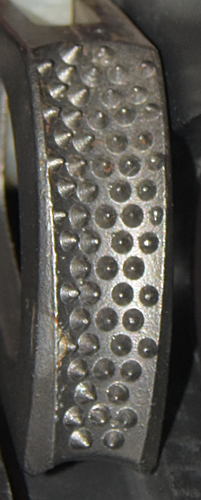 Technical Details
Technical Details
I acquired my CMI 5000, Version B in 2017 as part of Bob Thrun’s collection.
Version B is 184 mm. tall, 76 mm. wide, 27 mm. thick, and weighs 228 g.
Version B has chamfered top and bottom holes.
There are no markings on this pair.
This pair has prototype frames. According to Bob’s notes, he acquired these from the collection of Ray Seutur of the Cleveland Grotto. They were sold as a pair. Stickers on the ascenders and Bob’s notes state that these were not heat treated and should not be used.
Bob thought that these might be prototype 5001 frames, but I think that they are earlier than that. Around 2000, Ian Ellis of Speleoshoppe read me a press release indicating the "5001" was scheduled to have, among other changes, radiused versus chamfered tie-in holes. The frames on Version B have chamfered holes. I think that these are prototypes for the 5000, Version C. Version B has the chamfered holes and unmarked cam that Version C has and Version D does not.
The chamfered holes fix one of my issues with Version B.
|
 |
Warning:
This pair should not be used because the frame was not heat treated |
 |
|
[ Top
| 5000 Ver. A
| 5000 Ver. B
| 5000 Ver. C
| 5000 Ver. D
| 5000 Ver. E
| 5000 Ver. F
| 5000 Ver. H (5001)
]
[ 5002 Ver. A
| 5002 Ver. B
| 5002 Ver. C
| 5003 Ver. A
| 5003 Ver. B
| 5003 Ver. C
| 5003 Ver. D
| 5004 Ver. A
| 5004 Ver. B
| Return to H.E.C. Ascenders
]
5000, Version G
(a.k.a. "5001")
(#2220, 3541)
Technical Details
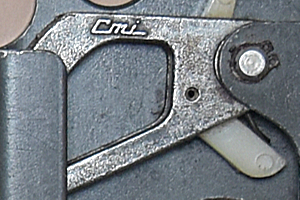
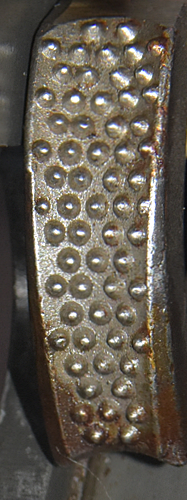 I acquired my right-handed CMI 5000, Version G in 2017 as part of Bob Thrun’s collection. I acquired a left-handed one from "M&M" (eBay seller halfstepnutchell) in 2022.
I acquired my right-handed CMI 5000, Version G in 2017 as part of Bob Thrun’s collection. I acquired a left-handed one from "M&M" (eBay seller halfstepnutchell) in 2022.
The CMI 5000, Version G is 184 mm. tall, 76 mm. wide, 27 mm. thick, and weighs 227 g.
Version G makes two significant changes to Version E. First, The cam pin has changed from a round head to a mushroom head, reducing the profile dramatically. A slight depression milled in the rear of the shell helps to further reduce the profile. Second, the lower attachment holes are chamfered again, as they were on Version C.
The cam has "Cmi" in raised letters.
The changes are small but welcome improvements that address some of my issues with Version A.
Note the minor change to the cam markings: It is now "Cmi" instead of "CMI."
The "5001" was apparently never given a new number, instead there were several versions of the 5000. Around 2000, Ian Ellis read me a press release indicating the "5001" was scheduled to have a stronger cam spring, a cam change to accommodate the new spring, a repositioned safety, and radiused versus chamfered tie-in holes. Despite the press release, a change to the safety did not appear until the 5003, and I would not call it repositioned until the UltrAscender appeared around 1989. The other changes were made incrementally, so the transition was gradual. For convenience, I use the new cam with "Cmi" instead of "CMI" as the indicator for the 5001.
[ Top
| 5000 Ver. A
| 5000 Ver. B
| 5000 Ver. C
| 5000 Ver. D
| 5000 Ver. E
| 5000 Ver. F
| 5000 Ver. G
| 5000 Ver. H (5001)
]
[ 5002 Ver. B
| 5002 Ver. C
| 5003 Ver. A
| 5003 Ver. B
| 5003 Ver. C
| 5003 Ver. D
| 5004 Ver. A
| 5004 Ver. B
| Return to H.E.C. Ascenders
]
5002, Version A
(#3654)
Technical Details
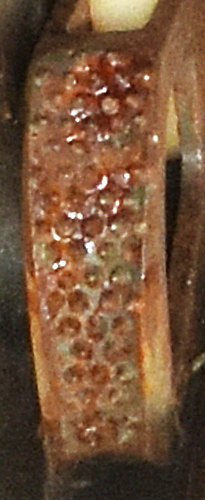 I acquired a right-handed CMI 5002, Version A from Deane Zelaya in 2024.
I acquired a right-handed CMI 5002, Version A from Deane Zelaya in 2024.
The CMI 5002, Version A is 184 mm. tall, 77 mm. wide, 28 mm. thick, and weighs 219 g. The rope channel is 14 mm. wide. The pivot is centered 47 mm. from the inside of the rope channel. The cam radius increases from 33 to 51 mm. over an angle of 48°, giving a 28° cam angle. The tooth pattern is (2)(5.4)^4(3.4)(3.2)^3. The conical teeth are well formed, more so than on the 5000. The teeth are still perpendicular to the cam face. "Cmi" is cast on the side of the cam.
There are several changes between the 5000 and 5002. The cam was redesigned with somewhat more reinforcing than the 5000 cam. The spring channel in the cam has been enlarged to accommodate a stronger cam spring. The cam pin has a smaller head, and the safety pivot diameter was increased.
The frame is essentially identical to the 5000/"5001" frame except for the rope channel, which has been increased in height and given a triangular termination. The lower and upper tie-in holes are radiused. This ascender has the typical dark gray anodizing of most early C.M.I. ascenders.
The stronger cam spring is an improvement which causes the cam to grip more reliably, although it also makes operating the cam safety and opening the cam more difficult. There are too many cam teeth. Too many teeth causes the 5002 (and similarly the 5000)to perform less satisfactorily in mud than the 5003 and 5004. I don't know why the left ascender has one more top-row tooth than the right, but it is probably nothing more than different manufacturing lots.
The increased height for the rope channel is more than a cosmetic
improvement. One strange feature of the 5000 was that the rope-cam
contact point was well below the center elevation of the rope
channel. The 5002 design places the contact point much closer
to channel mid-elevation. This is a much cleaner design than the
original and indicates at least some attention to detail.
This ascender has the milled recess for the cam axle head found on my "5001" frames. This recess is unnecessary because the axle pin was lengthened and is now long enough to extend through the frame with clearance to spare.
The radiused tie-in holes are a nice improvement.
[ Top
| 5000 Ver. A
| 5000 Ver. B
| 5000 Ver. C
| 5000 Ver. D
| 5000 Ver. E
| 5000 Ver. F
| 5000 Ver. G
| 5000 Ver. H (5001)
]
[ 5002 Ver. A
| 5002 Ver. C
| 5003 Ver. A
| 5003 Ver. B
| 5003 Ver. C
| 5003 Ver. D
| 5004 Ver. A
| 5004 Ver. B
| Return to H.E.C. Ascenders
]
5002, Version B
(#2385)
Technical Details
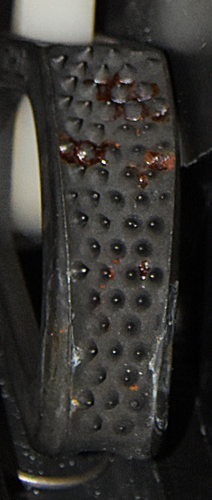 I acquired my CMI 5002, Version B pair from Michael Schultz in 2019.
I acquired my CMI 5002, Version B pair from Michael Schultz in 2019.
The CMI 5002, Version B is 184 mm. tall, 77 mm. wide, 28 mm. thick, and weighs 219 g. The rope channel is 14 mm. wide. The pivot is centered 47 mm. from the inside of the rope channel. The cam radius increases from 33 to 51 mm. over an angle of 48°, giving a 28° cam angle. The tooth pattern for the left ascender is (3)(5.4)^4(3.4)(3.2)^3 and for the right ascender is (2)(5.4)^4(3.4)(3.2)^3. The conical teeth are well formed, more so than on the 5000. The teeth are still perpendicular to the cam face. "Cmi" is cast on the side of the cam.
There are several changes between the 5000 and 5002. The cam was redesigned with somewhat more reinforcing than the 5000 cam. The spring channel in the cam has been enlarged to accommodate a stronger cam spring. The cam pin has a smaller head, and the safety pivot diameter was increased.
The frame is essentially identical to the 5000 frame except for the rope channel, which has been increased in height and given a triangular termination. The lower and upper tie-in holes are radiused. This ascender has the typical dark gray anodizing of most early C.M.I. ascenders.
This version eliminates the milled recess for the cam axle found on on the rear of the frame for the CMI "5001."
[ Top
| 5000 Ver. A
| 5000 Ver. B
| 5000 Ver. C
| 5000 Ver. D
| 5000 Ver. E
| 5000 Ver. F
| 5000 Ver. G
| 5000 Ver. H (5001)
]
[ 5002 Ver. A
| 5002 Ver. B
| 5003 Ver. A
| 5003 Ver. B
| 5003 Ver. C
| 5003 Ver. D
| 5004 Ver. A
| 5004 Ver. B
| Return to H.E.C. Ascenders
]
5002, Version C
(#28, 107, 1545, 2224)
Technical Details
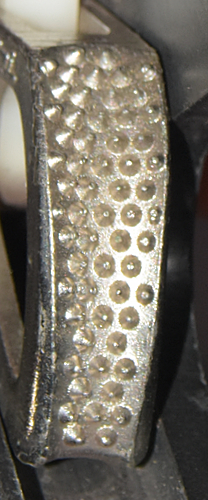 I acquired two left-handed C.M.I. 5002, Version C ascenders from Speleoshoppe in October 1989. I acquired a used pair from Barry Kooda in March 2004, and another pair (later given to Артём Бабин) from Daniel Abend in 2011. I acquired another pair in 2017 as part of Bob Thrun’s collection.
I acquired two left-handed C.M.I. 5002, Version C ascenders from Speleoshoppe in October 1989. I acquired a used pair from Barry Kooda in March 2004, and another pair (later given to Артём Бабин) from Daniel Abend in 2011. I acquired another pair in 2017 as part of Bob Thrun’s collection.
The CMI 5002 Version C is 184 mm. tall, 76 mm. wide, 28 mm. thick, and weighs 220 g. The rope channel is 14 mm. wide. The cam radius increases from 33 to 51 mm. over an angle of 48°, giving a 28° cam angle. The 5002 ascenders in my collection have slightly different tooth patterns. Some have a (3)(5.4)^4(3.4)(3.2)^3 count, while others have (2)(5.4)^4(3.4)(3.2)^3.
The CMI 5002 Version C cam is also plated, while previous cams were unfinished.
The steel in the CMI-5000 series ascenders was slightly susceptible to rusting, but with proper care, this was not an issue. The plating provided some protection against rust, at least until the teeth started to wear.
[ Top
| 5000 Ver. A
| 5000 Ver. B
| 5000 Ver. C
| 5000 Ver. D
| 5000 Ver. E
| 5000 Ver. F
| 5000 Ver. G
| 5000 Ver. H (5001)
]
[ 5002 Ver. A
| 5002 Ver. B
| 5002 Ver. C
| 5003 Ver. B
| 5003 Ver. C
| 5003 Ver. D
| 5004 Ver. A
| 5004 Ver. B
| Return to H.E.C. Ascenders
]
5003, Version A
(#3661)
Technical Details
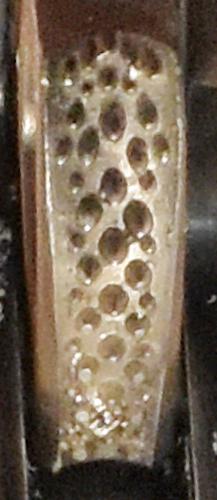 I acquired this CMI 5003, Version A from Bruce Watts in 2025.
I acquired this CMI 5003, Version A from Bruce Watts in 2025.
This CMI 5003 version is 184 mm. tall, 77 mm. wide, 27 mm. thick, and weighs 236 g. The rope channel is 17 mm. wide.
This ascender is very similar to the C.M.I. 5000, even though it is three versions later. The frame extrusion has been substantially thickened in the rope channel area, and is now finished in a black epoxy(?) paint. The remainder of the frame appears to have been beefed up, but the extra thickness may only be paint. The three sling holes are now beveled.
The cam has been modified in several ways and matches the Shorti III cam.The cam is a plated skeletonized steel casting, with an internal
brace. The teeth are conical with a (1)(2.3)^2(4.3)(2.3)^5(2)
tooth count. The teeth axes are parallel to the upper surface
of the cam, and decrease in size towards sides of the cam. The
teeth are fairly dull compared to those of other toothed ascenders,
and the lower teeth had their points ground flat during manufacture,
probably unintentionally. The cam radius, measured from the pivot,
increases from 36 to 50 mm. over an angle of 48 degrees.
The cam pivot is a solid 6.4 mm. pin held by an external
retaining ring. The pivot is centered 47 mm. from the inside
of the rope groove. The cam safety is similar to the Shorti’s,
and functions in the same manner. The safety is molded plastic,
and the enlarged actuating lever lies along the top of the cam
rather than sticking up from the cam. The roll pin is larger than
in the Shorti. A single spring serves as cam spring and safety
spring.
The cam safety is now molded, and the enlarged actuating lever lies along the top of the cam rather than sticking up from the cam. The cam safety is the same as on the C.M.I. Shorti III. The cam pivot head is flatter than on the C.M.I. 5000, and the safety pivot is larger in diameter.
The ascender is very well made. In my opinion, the extra frame thickness is superfluous since the C.M.I. 5000 frame was already very strong. The cam spring is stronger than the C.M.I. 5000 spring and functions adequately. Orienting the cam teeth axes parallel to the top of the ascender cam is an improvement. This design gives the teeth a slight downwards alignment with respect to the climbing rope. This increases their grip, reduces tooth friction while raising the ascender, and provides a small self cleaning action.
The ascender can be opened with one hand, but the safety is even more awkward than on the C.M.I. 5000. I suspect that the new design was developed to reduce the risk of accidentally opening the ascender, but I don't find this to be a problem.
The safety on my right-hand ascender was broken in use. This was a common problem with the 5003, 5004, Shorty III and Shorty IV ascenders.
[ Top
| 5000 Ver. A
| 5000 Ver. B
| 5000 Ver. C
| 5000 Ver. D
| 5000 Ver. E
| 5000 Ver. F
| 5000 Ver. G
| 5000 Ver. H (5001)
]
[ 5002 Ver. A
| 5002 Ver. B
| 5002 Ver. C
| 5003 Ver. A
| 5003 Ver. C
| 5003 Ver. D
| 5004 Ver. A
| 5004 Ver. B
| Return to H.E.C. Ascenders
]
5003, Version B
(#3677)
Technical Details
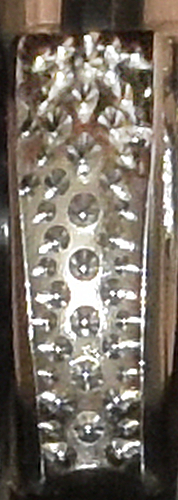 I acquired this CMI 5003, Version A from Paul Icon in 2025.
I acquired this CMI 5003, Version A from Paul Icon in 2025.
This CMI 5003 version is 184 mm. tall, 77 mm. wide, 29 mm. thick, and weighs 244 g. The rope channel is 18 mm. wide.
The cam is a chrome-plated skeletonized steel casting, with an internal
brace. The cam axle is a solid 6.4 mm. pin held by an external
retaining ring. It is centered 47 mm. from the inside of the rope channel. The cam radius, measured from the axle axis, increases from 32 to 51 mm. over an angle of 48°, giving a 29° cam angle. The tooth pattern is (1)(2.3)^2(4.3)(2.3)^5(2). The cam pivot is a solid 6.4 mm. pin held by an external
retaining ring.
The cam has "Cmi" in raised letters on each side of the cam.
I like the chrome-plated cam, as it will resist wear quite well.
[ Top
| 5000 Ver. A
| 5000 Ver. B
| 5000 Ver. C
| 5000 Ver. D
| 5000 Ver. E
| 5000 Ver. F
| 5000 Ver. G
| 5000 Ver. H (5001)
]
[ 5002 Ver. A
| 5002 Ver. B
| 5002 Ver. C
| 5003 Ver. A
| 5003 Ver. B
| 5003 Ver. D
| 5004 Ver. A
| 5004 Ver. B
| Return to H.E.C. Ascenders
]
5003, Version C
(#29)
Technical Details
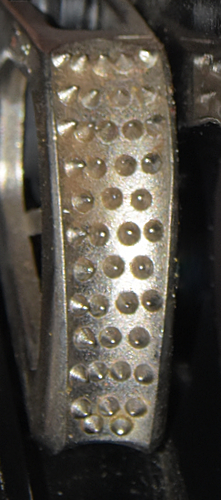 I acquired this pair of ascenders from Bob & Bob at the 1987 N.S.S. Convention.
I acquired this pair of ascenders from Bob & Bob at the 1987 N.S.S. Convention.
This CMI 5003 version is 183 mm. tall, 77 mm. wide, 27 mm. thick, and weighs 236 g. The rope channel is 17 mm. wide.
This ascender is very similar to the C.M.I. 5000, even though it is three versions later. The frame extrusion has been substantially thickened in the rope channel area, and is now finished in a black epoxy(?) paint. The remainder of the frame appears to have been beefed up, but the extra thickness may only be paint. The three sling holes are now beveled.
The cam has been modified in several ways and matches the Shorti IV cam. A reinforcing bar now extends from the back of the cam face arc to the mid-bottom of the cam, providing better cam face support under load. The cam radius increases from 32 to 51 mm. over an angle of 48°, giving a 29° cam angle. The conical teeth are larger, sharper, and better made, and the tooth count has been changed to (5.4)^2(3.4)^3(3.2). The teeth are now oriented parallel to the top of the cam. The cam finish appears to be plated, but this may be just a change in alloy or heat treating. "Cmi" is cast on the side of the cam.
The cam safety is now molded, and the enlarged actuating lever lies along the top of the cam rather than sticking up from the cam. The cam safety is the same as on the C.M.I. Shorti III. The cam pivot head is flatter than on the C.M.I. 5000, and the safety pivot is larger in diameter.
This ascender’s cam is identical to the 5004 cam. It is also used on later Shorty IIIs and the Shorty IV. I don't notice a significant performance difference between the two cam designs.
The safety is cracked on one ascender, indicating that a tougher plastic is needed for the cam safeties.
[ Top
| 5000 Ver. A
| 5000 Ver. B
| 5000 Ver. C
| 5000 Ver. D
| 5000 Ver. E
| 5000 Ver. F
| 5000 Ver. G
| 5000 Ver. H (5001)
]
[ 5002 Ver. A
| 5002 Ver. B
| 5002 Ver. C
| 5003 Ver. A
| 5003 Ver. B
| 5003 Ver. C
| 5004 Ver. A
| 5004 Ver. B
| Return to H.E.C. Ascenders
]
5003, Version D
(#3597)
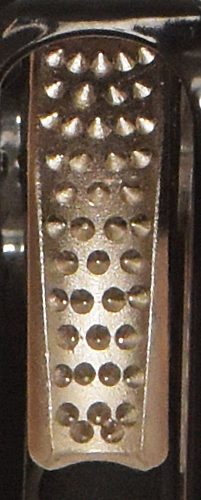 Technical Details
Technical Details
I acquired this pair of ascenders from Jason Macht in 2023.
This CMI 5003 version is 185 mm. tall, 76 mm. wide, 29 mm. thick, and weighs 249 g. The rope channel is 18 mm. wide.
The only discernible difference between this ascender and the previous 5003 version is in the rope channel design. This ascender's rope channel extends farther towards the cam pivot and has a small lip inside.
The cam has "Cmi" in raised letters.
In 1986 C.M.I. issued a press release noting that "under some unusual circumstances [the C.M.I.] 5003 and Shorty III ascenders can be forced off the rope." They addressed the issue by introducing the 5004 with a modified shell, adding a small lip inside the rope channel and extending the channel backward.
This 5003 shows that there were some hybrid versions made. This version has 5003 safeties and stickers (so it is definitely a 5003), but a 5004 frame and cam.
[ Top
| 5000 Ver. A
| 5000 Ver. B
| 5000 Ver. C
| 5000 Ver. D
| 5000 Ver. E
| 5000 Ver. F
| 5000 Ver. G
| 5000 Ver. H (5001)
]
[ 5002 Ver. A
| 5002 Ver. B
| 5002 Ver. C
| 5003 Ver. A
| 5003 Ver. B
| 5003 Ver. C
| 5003 Ver. D
| 5004 Ver. B
| Return to H.E.C. Ascenders
]
5004, Version A
(#30, 2223, 3488)
Technical Details
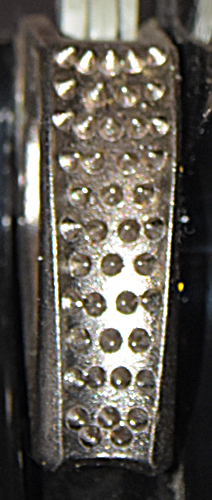 I acquired a right-hand C.M.I. 5004 ascender from Bob & Bob at the 1989 Old Timers Reunion. I acquired a left-hand ascender from Speleoshoppe two weeks later. I acquired another pair in 2017 as part of Bob Thrun’s collection. I acquired a third pair from Chris White in 2021, and donated it to to Artyom Babin (Артём Бабин).
I acquired a right-hand C.M.I. 5004 ascender from Bob & Bob at the 1989 Old Timers Reunion. I acquired a left-hand ascender from Speleoshoppe two weeks later. I acquired another pair in 2017 as part of Bob Thrun’s collection. I acquired a third pair from Chris White in 2021, and donated it to to Artyom Babin (Артём Бабин).
These CMI 5004s are 183 mm. tall, 78 mm. wide, 29 mm. thick, and weighs 245 g. The rope channel is 18 mm. wide. The cam radius increases from 32 to 51 mm. over an angle of 48°, giving a 29° cam angle. The tooth pattern is (5.4)^2(3.4)^3(3.2).
The only discernible difference between this ascender and the 5003 is in the rope channel design. The 5004 rope channel extends farther towards the cam pivot and has a small lip inside.
In 1986 C.M.I. issued a press release noting that "under some unusual circumstances [the C.M.I.] 5003 and Shorty III ascenders can be forced off the rope." It is possible to get some thinner, soft lay ropes to pull out between the cam and the side of the rope channel if one works at it a while, but I have been completely unsuccessful in pulling 11 mm. P.M.I. out of my pair of 5003s under any reasonable circumstances. There is no doubt that the 5004 provides more rope security than the 5003, but I have no practical worries about either one of these ascenders.
My friend Ken Kramer reports that his safeties broke on the way to their first cave trip. Obviously the change in plastic did not completely fix breaking safety problem.
[ Top
| 5000 Ver. A
| 5000 Ver. B
| 5000 Ver. C
| 5000 Ver. D
| 5000 Ver. E
| 5000 Ver. F
| 5000 Ver. G
| 5000 Ver. H (5001)
]
[ 5002 Ver. A
| 5002 Ver. B
| 5002 Ver. C
| 5003 Ver. A
| 5003 Ver. B
| 5003 Ver. C
| 5003 Ver. D
| 5004 Ver. A
| 5004 Ver. B
]







